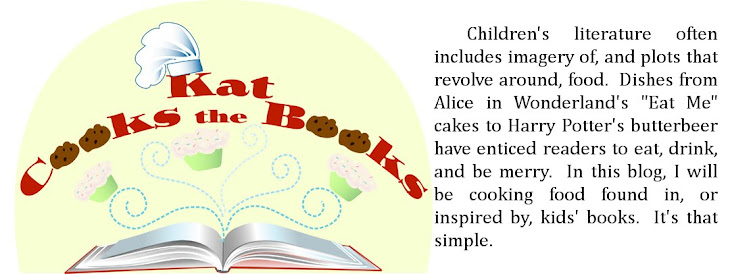This may not be the prettiest dish I've ever made, but I really wanted to tell you about this book!
I'm well aware that this is not the healthiest blog on the planet. My justification for making cakes, cookies, ice creams, and other bad-for-you foods is usually somewhere along the lines of, "but I can get excited about butterbeer and eat-me cakes and pink peppermint ice cream! Nobody wants to watch me make a salad!" But you know what? I need to get more excited about healthy foods, too, and if anything is going to make me cheer for vegetables, it's Rah, Rah, Radishes! A Vegetable Chant by April Pulley Sayre.
There are beautiful, mouth-watering photos of any number of vegetables in this book, which look like they were taken at a local farmer's market. These are paired with a fun, energetic cheer to create a really fun book that I must have flipped through 5 or 6 times.
The author mentions the usual veggies, but doesn't stop at peas and carrots. Yams, squash, parsnips, rutabagas, and multiple types of peppers are shown - jalapeno, serrano, habanero. She even shows veggies that I (I admit with some degree of embarrassment) have never tried, like fennel, Swiss chard, and kale, and a few (kohlrabi, bok choy) that I wouldn't even have known what they were if they were placed in front of me.
The veggies are paired into families of related produce, so the combinations work well together, and the rhymes don't seem forced, though they're not using just veggies to make the chant flow. ("Onion. Scallion. Leek and shallot. Grab that garlic. Please your palate!")
I love that the author also added in "Thank you, farmers. Thank you, bees.", as if to open discussion on where the vegetables actually come from, and she suggests in the very back of the book that each family member become an expert on one certain vegetable - how and where it grows, how to cook it, what it tastes like - and then, once that person has taught all the others about it, they can pick up a new veggie and start over. Cool idea! The last page also mentions, "Note: no vegetables were harmed or mistreated in the making of this book. Most, however, were later eaten."
Now, this is not an alphabet book, but the short, catchy chant, and the bright, beautiful photos, I believe, would appeal to the same audience as those working on their ABCs, so I made for you a lovely alphabet-pasta-with-veggies dish, that I first saw in one of those magazines that the supermarket puts out for free. I've adapted it a bit, but the inspiration comes from Publix's "Toddler Pasta" recipe.
Alpha-Veggie Pasta
4 cups chicken or vegetable broth (I used low-sodium)
1 cup alphabet pasta
2/3 cup mixed frozen peas and carrots
2/3 cup frozen broccoli (I chopped it into bite-sized pieces before I measured)
1/2 cup grated Parmesan cheese
1 tbsp. olive oil
Salt and pepper to taste
1) Put the broth in a large (spaghetti-type) pot and bring to a boil. You can use regular old salted water, if you like, but the broth adds a lot of flavor to the party.
2) Add the pasta and boil, stirring occasionally, for 7 minutes.
3) Add the frozen veggies and boil the whole thing for another 6 minutes.
4) Drain the chicken broth, and set it aside. Mix in the olive oil, cheese, and salt and pepper, adding in more broth as necessary to make it have a nice coating. (I also put some of the broth into tupperware containers with the leftovers, since the pasta might get a little dry when you reheat it in the microwave.)
Incidentally, the letter-shaped pasta holds up really well in the fridge. I've been eating this for lunch for the past few days, and it's not mushy at all!
See? You can read every letter! (Hmm... I wonder what those initials stand for.)
As we discussed a while back, I'm partial to lima beans; what's your favorite veggie?
.jpg)






